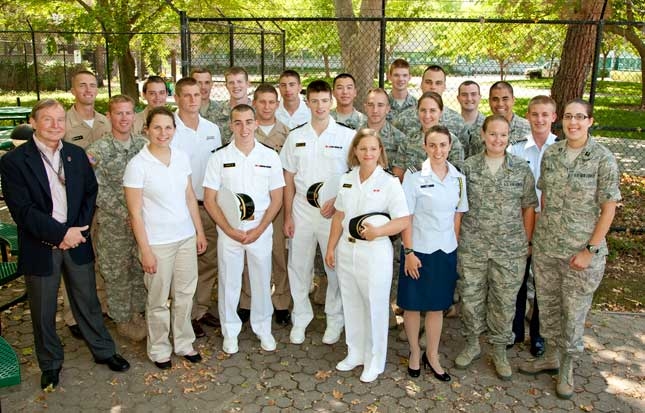Future U.S. military leaders strengthen bond with LLNL
 (Download Image)
(Download Image)
This year, the Laboratory is sponsoring 23 cadets and midshipmen, one academy faculty, and 13 ROTC cadets.
Senior Laboratory managers had the opportunity to meet with future American military leaders at the MARA (Military Academic Research Associates) and Reserve Officer Training Corps (ROTC) intern reception last week in the West Cafeteria.
The annual reception is a chance for these participants to learn more from senior managers about LLNL's mission in national security scientific areas, and is part of ongoing Laboratory intern programs aimed at maintaining an invaluable relationship.
According to reception host George Sakaldasis, deputy director for Military and Nuclear Affairs in the Laboratory's National Security Office (NSO), the MARA and the ROTC intern programs are vital for both the Laboratory and the U.S. Department of Defense (DoD).
"These are up-and-coming military officers getting a look at both the capabilities and responsibilities of LLNL and the National Nuclear Security Administration [NNSA]," Sakaldasis said. "Someday in the future, when they're wearing gold bars and come across a problem that DoD can't solve, they'll remember what Livermore and NNSA can do."
By the time U.S. Air Force Col. Sakaldasis first came to the Laboratory as the U.S. STRATCOM representative in 1993, there were only a half-dozen U.S. military officers on long-term assignments here. But during the Cold War, there were 40 or 50 Army, Navy, Air Force, and Marine Corps officers here at any time on roughly three-year assignments, working side by side with nuclear weapon designers.
"These officers learned about nuclear design and taught us about military operations," Sakaldasis said. "After leaving their billets here, they were promoted at about 10 times the rate of their peers. It was invaluable for everyone."
But between 1992 and 1995, after the Cold War ended, the U.S. military lost about 500,000 troops. By 1996, when Sakaldasis retired from the Air Force to join LLNL, there were only three or four officers with LLNL assignments, and within two years, all the old programs had been discontinued.
Since then, however, NSO has been regrowing Livermore's military presence, primarily through military intern programs.
According to John Crandley, an NSO Military and Nuclear Affairs specialist, there are currently six billeted officers at Livermore serving one- to three-year assignments, two each in the Air Force Fellows Program, the Defense Threat Reduction Agency Stockpile Associate Program, and the new Army Training with Industry Program. All six officers are majors or colonels.
Over the past few years, the NNSA Office of Defense Programs has made LLNL's program the model for NNSA and is now offering it at seven other Department of Energy (DOE) sites. As a result of this growing collaboration, NNSA Defense Programs is now funding the cost of hosting cadets and midshipmen assigned to LLNL from the various military academies.
Contact
Jason W Carpenter[email protected]
925-422-3678
Related Files
DownloadTags
Strategic DeterrenceFeatured Articles







